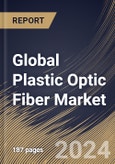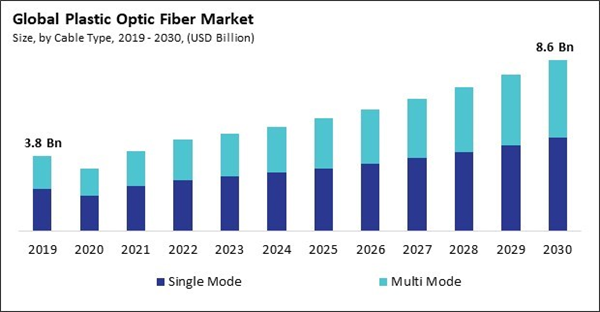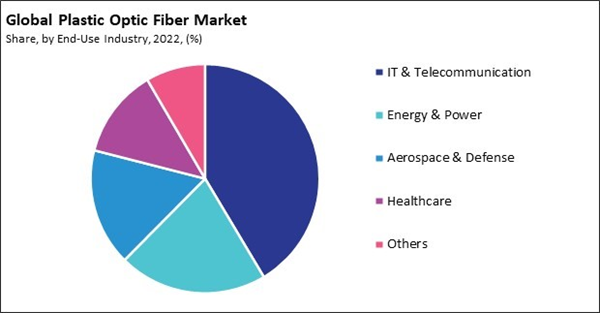The Global Plastic Optic Fiber Market size is expected to reach $8.6 billion by 2030, rising at a market growth of 8.4% CAGR during the forecast period.
POF is utilized in medical imaging devices, including endoscopes, cameras, and imaging systems. Therefore, the healthcare segment acquired $575.7 million revenue in 2022. Its flexibility and ability to transmit light efficiently make it suitable for applications where precise and high-quality imaging is essential for diagnostic purposes.
POF is inherently non-conductive, making it a safe choice for medical applications where electrical conductivity can pose risks. In environments where patient safety is paramount, such as medical imaging and diagnostics, the non-conductive nature of POF ensures that it does not interfere with sensitive medical equipment. POF is employed in endoscopy and medical imaging applications, where flexibility and biocompatibility are essential.
Additionally, POF is employed in infotainment systems to transmit audio and video signals. Its ability to provide high-quality, interference-free transmission enhances the performance of infotainment systems, contributing to a better user experience for passengers. Hence, expansion of automotive industry integration has been a pivotal factor in driving the growth of the market.
However, without global standards, there is a risk of interoperability issues when integrating POF into existing optical fiber networks. Different specifications or variations in POF technologies can lead to compatibility challenges, hindering the smooth communication and collaboration between systems and devices. Thus, lack of global standardization can slow down the growth of the market.
POF is utilized in medical imaging devices, including endoscopes, cameras, and imaging systems. Therefore, the healthcare segment acquired $575.7 million revenue in 2022. Its flexibility and ability to transmit light efficiently make it suitable for applications where precise and high-quality imaging is essential for diagnostic purposes.
POF is inherently non-conductive, making it a safe choice for medical applications where electrical conductivity can pose risks. In environments where patient safety is paramount, such as medical imaging and diagnostics, the non-conductive nature of POF ensures that it does not interfere with sensitive medical equipment. POF is employed in endoscopy and medical imaging applications, where flexibility and biocompatibility are essential.
Additionally, POF is employed in infotainment systems to transmit audio and video signals. Its ability to provide high-quality, interference-free transmission enhances the performance of infotainment systems, contributing to a better user experience for passengers. Hence, expansion of automotive industry integration has been a pivotal factor in driving the growth of the market.
However, without global standards, there is a risk of interoperability issues when integrating POF into existing optical fiber networks. Different specifications or variations in POF technologies can lead to compatibility challenges, hindering the smooth communication and collaboration between systems and devices. Thus, lack of global standardization can slow down the growth of the market.
By Cable Type Analysis
By cable type, the market is categorized into single mode and multi mode. The multi mode segment acquired 44% revenue share in the market in 2022. Multi-mode POF is compatible with low-cost light sources, such as light emitting diodes (LEDs). his includes applications in home audio systems, professional audio setups, and multimedia installations where reliable and cost-effective audio transmission is crucial.By End-Use Industry Analysis
Based on end-use industry, the market is classified into IT & telecommunication, energy & power, healthcare, aerospace & defense, and others. In 2022, the IT & telecommunication segment witnessed 41.4% revenue share in the market. POF, with its ability to support high bandwidth and low latency, finds applications in 5G network infrastructure. POF's characteristics, such as flexibility and ease of installation, contribute to its use in the manufacturing processes of telecommunications equipment.By Regional Analysis
Region-wise, the market is analysed across North America, Europe, Asia Pacific, and LAMEA. In 2022, the Asia Pacific region led the market by generating 49.2% revenue share. The Asia Pacific region has seen widespread adoption of emerging technologies and the IoT. Asia Pacific is a hub for manufacturing and industrial activities.List of Key Companies Profiled
- Corning Incorporated
- Prysmian Group
- Sumitomo Electric Industries, Ltd.
- Yangtze Optical Fibre and Cable Joint Stock Limited Company
- Fujikura Ltd.
- Leoni AG
- Hengtong Group Co., Ltd.
- Finolex Cables Ltd. (Finolex Group)
- PCT International, Inc.
- Coherent Corp.
Market Report Segmentation
By Cable Type- Single Mode
- Multi Mode
- IT & Telecommunication
- Energy & Power
- Aerospace & Defense
- Healthcare
- Others
- North America
- US
- Canada
- Mexico
- Rest of North America
- Europe
- Germany
- UK
- France
- Russia
- Spain
- Italy
- Rest of Europe
- Asia Pacific
- China
- Japan
- India
- South Korea
- Singapore
- Malaysia
- Rest of Asia Pacific
- LAMEA
- Brazil
- Argentina
- UAE
- Saudi Arabia
- South Africa
- Nigeria
- Rest of LAMEA
Table of Contents
Chapter 1. Market Scope & Methodology
Chapter 2. Market at a Glance
Chapter 3. Market Overview
Chapter 4. Global Plastic Optic Fiber Market by Cable Type
Chapter 5. Global Plastic Optic Fiber Market by End-Use Industry
Chapter 6. Global Plastic Optic Fiber Market by Region
Chapter 7. Company Profiles
Companies Mentioned
- Corning Incorporated
- Prysmian Group
- Sumitomo Electric Industries, Ltd.
- Yangtze Optical Fibre and Cable Joint Stock Limited Company
- Fujikura Ltd.
- Leoni AG
- Hengtong Group Co., Ltd.
- Finolex Cables Ltd. (Finolex Group)
- PCT International, Inc.
- Coherent Corp.
Methodology

LOADING...










